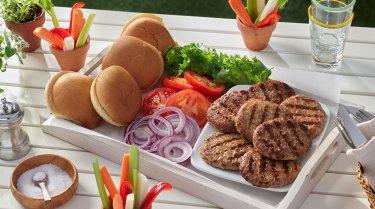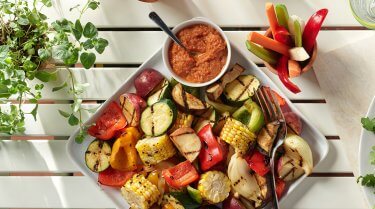
Now that spring is here and summer is peeking around the corner, can anyone stop thinking about grilling? Indeed, it’s hard to find a downside to outdoor cooking and the kind of easy, breezy, casual meals and gatherings it fuels so well.
Extolling the virtues of outdoor grilling to the Hormel Foods team I work with is like preaching to the proverbial choir. The company makes a large assortment of products that work as well on a grill as they do on a conventional stove or in a kitchen oven. And because grilling offers entirely different flavors and textures, it’s easy to get more mileage out of favorite food items.

“Grilling is a wonderful way to create delicious, smoky flavor while keeping meat nice and juicy,” says Joan Hanson, director of the test kitchen at the global headquarters of Hormel Foods. “By experimenting with ethnic flavors and spices, you add can give new twists to standby items like hamburgers and chicken.”
As a personal chef and caterer for the past 17 years, I’ve done my fair share of grilling. Over the years, I’ve also worked with many clients looking to learn the delicious art of this outdoor culinary skill. For some, grilling looks easy – I mean Uncle Rob can do it, right? For others it appears daunting.
I couldn’t live without my grill, and by grill, I’m talking about more than a burger (not that there’s anything wrong with that!). Read on for simple ideas about how to get the most from your grill.
Charcoal or Gas?
There are pros and cons to each. The ease of turning your outdoor grill on with a knob and controlling the temperature in the same way you would your indoor cooktop is definitely appealing. But learning how to grill with charcoal is not difficult and can actually feel more rewarding.
In addition to the major cost difference (a classic barrel-shaped grill sells for about $100 versus a decent gas grill, which would be anywhere from $300 to $1,000 or more), I enjoy the smoky flavor that comes from grilling over charcoal instead of gas. If you’d like to dip a toe into charcoal-grill territory, keep the following info in mind.
- Natural/hardwood charcoal versus charcoal briquettes. Natural charcoal burns hotter and faster than charcoal briquettes. This is important for timing. If you’re using briquettes, you’ll have to start your fire earlier. On the other hand, if you’re using natural charcoal, your coals will be ready sooner, but you may have to do two rounds of cooking if they die down before you’re done grilling.
- Skip the lighter fluid. First off, the giant flaming “situation” is daunting, and lighter fluid adds an unpleasant chemical flavor to your food. Instead, invest in an electric starter or chimney starter (each is only $10-$20).
- Arrange your coals. There is some debate here, but I like to arrange my coals in a wide pyramid. This allows me to create different temperature zones. Hotter in the middle and cooler around the edges. I can move the food around the grill as I need to – for instance, if my steak is cooking too quickly, I can simply move it to the outer edge to ensure it’s not grilled on the outside but raw inside.
- Be patient. It’s true you can’t just turn the grill on and off, but a little patience goes a long way. Make sure you wait for the coals to start becoming ashy before you begin your grilling. This gives the grill enough time to get hot and for the heat to be more evenly distributed.
- Manage your time. This may be the most important rule for grilling with charcoal. You can’t just put everything on the grill at the same time. The grill is hottest when you first light it, so this is a good time to put items on the grill that are essentially fully cooked but need to be heated through. I always start with hot dogs, because they cook quickly, and I can put these out right away (especially for the kiddos). Veggies also don’t require much time on the grill (invest in a grill basket so they don’t fall into the coals). Seafood is up next, and your meats should go on last, as they need more time to cook through.
Grilling Fish and Seafood
Grilling seafood is quick, easy and delicious. The biggest mistake I have come across is placing your fish directly on the grill. While this is perfectly fine for shellfish (I recently started grilling snow crab legs – so tasty), you should opt for a grill pan, cedar plank or even a (pizza) stone. Fish is delicate and can fall apart without a flat surface. Additionally, many types of fish have a good amount of fat in the skin, which is what creates the moist texture you want to achieve. Make sure you heat your surface first to ensure even cooking. I also like to put the lid on to get a good smoky flavor! And remember – you don’t need to cook seafood very long. Just a few minutes will get the job done.
Burger Heaven

Burgers are probably the MOST quintessential grilled item (just edging out their hot dog rivals, IMO). They are also my absolute favorite food! And while they might seem like the simplest thing in the world to grill and enjoy, there are some pitfalls to avoid and ways to take them from great to sheer heaven.
- Don’t overly seasoning in advance. Growing up, my parents would do the most with the ground meat the day before. This is great if you like your burgers to taste like a grilled meatloaf patty. Over the years, I’ve learned that buying high-quality meat and keeping the seasoning pretty basic create a way better burger. First off, the meat doesn’t start to “cook” from all the stuff you’ve mixed into it. Second, you get a great meaty flavor with a good char on the outside and juiciness on the inside. This doesn’t mean you can’t get crazy with the cheese, or sauces and toppings, but keep the burger seasoning simple. I recommend kosher salt, freshly ground pepper, garlic and onion powder.
- A little fat is where it’s at. If you’re going for a great grilled burger, it’s not the time to worry about your calorie intake. Opt for ground chuck, rib or porterhouse, where the fat is so wonderfully marbled throughout the meat. My go-to is 80/20 chuck. Nobody regrets a great juicy burger – EVER!
- Plan for shrinkage. This is probably the biggest mistake I’ve seen. You have to remember that with all that fat melting, your burger is going to lose about 30 percent of its volume. Keep this in mind when forming your patties. I like to shape mine a bit wide and flat, so the end result is one that fits perfectly on the bun, rather than ending up looking like the dreaded “hockey puck.”
- Get creative with your condiments. The sky’s the limit when it comes to condiments and toppings for your burgers. In addition to the classic ketchup, mustard and pickle relish, how about salsas, guacamole and street sauces. Let your imagination run wild.
Eat Your (Grilled) Veggies

Veggies are just about the easiest food to grill, but there are tips worth taking. Because there is no worry about getting anyone sick for “undercooking” veggies, they don’t always get the same love and attention as their meat counterparts.
- Veggies cook VERY fast. Because veggies are mostly water, they cook quickly. For that reason, be careful not to put them on a grill that is too hot. And (with the exception of corn wrapped in foil), you shouldn’t walk away from them. They can burn quickly.
- Serve a grilled salad. Grill your lettuce for an easy salad that will wow at the same time. Drizzle some olive oil on romaine lettuce hearts, grill until lightly charred and serve with grilled tomatoes. Add bacon bits and a pesto vinaigrette. Presto!
- Invest in a grill basket. After losing many spears of asparagus to the abyss below the grill grate, I finally invested in a grill basket. It allows me to throw everything inside, from sweet Vidalia onions to summer squash. Definitely a game-changer.
- Don’t forget fruit. For a low-calorie and delicious dessert, how about grilled fruit? Just brush some canola oil on apples, pears, peaches – anything, really – add a dash of cinnamon, place on skewers and grill for a few minutes.
Play It Safe
You can’t be too cautious where food safety is concerned. Always remember:
- Keep foods refrigerated until you are ready to use/serve them.
- Thaw your meat in the refrigerator or a cooler. Never let it defrost at room temperature or in the sun.
- Invest in a meat thermometer and cook your meat to the recommended temp.
- When in doubt, throw it out. After your meal is over, throw away leftovers that have become wet or have been left out for an hour or more on hot days.
Before I sign off and head over to my grill, I’d like to leave you with one of my all-time favorite grilling techniques. This isn’t a mistake you have to avoid, but something I started doing about 15 years ago and never turned back. I don’t grill my corn on the cob. (I know it sounds controversial, but stay with me.) I hate how it gets stuck in my teeth, but I love summer corn so much. So, I cut the corn off the cob and prepare it in a grill pan. You don’t have to cook it for long – only about five to seven minutes. Not only does it capture more of the smoky flavor when it’s not inside a husk and layer of foil, it’s so much easier to eat. Add a few pats of good butter, plus some salt to the pan while it’s cooking. I promise you won’t be disappointed.
Happy grilling!
Chef Vanessa Cantave
www.vanessacantave.com
www.yumyumchefs.com
IG: @vanessacantave
